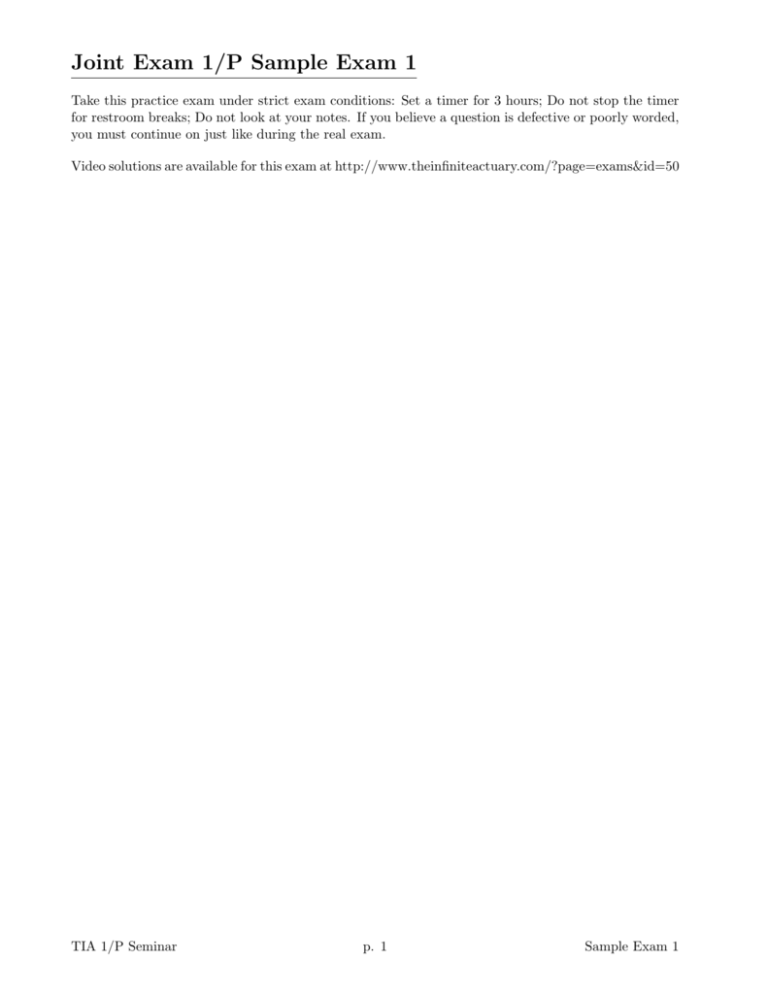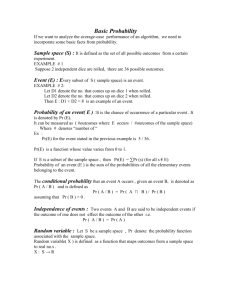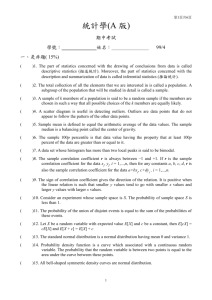Joint Exam 1/P Sample Exam 1
advertisement

Joint Exam 1/P Sample Exam 1
Take this practice exam under strict exam conditions: Set a timer for 3 hours; Do not stop the timer
for restroom breaks; Do not look at your notes. If you believe a question is defective or poorly worded,
you must continue on just like during the real exam.
Video solutions are available for this exam at http://www.theinfiniteactuary.com/?page=exams&id=50
TIA 1/P Seminar
p. 1
Sample Exam 1
1. 75% of the customers of ACME Mutual Insurance have auto insurance, and 40% have homeowners
insurance. What is the maximum possible probability that a randomly selected customer with auto
insurance does not have homeowners insurance?
A. 20%
B. 40%
C. 60%
D. 80%
E. 100%
2. Suppose Z is a normal random variable with EZ = 2 and coefficient of variation 3. Find P[Z > 1].
A. 0.05
B. 0.34
C. 0.57
D. 0.66
E. 0.95
3. The random variables X and Y are uniformly distributed over the set X > 0, Y > 0 and X + Y < 1.
What is the variance of X?
A. 1/36
B. 1/18
C. 1/12
D. 1/9
E. 1/6
4. The probability that Rafael Nadal wins a tennis match in straight sets is 70%. Assuming that the
outcome of each match is independent, what is the probability that in his next 7 matches that he will
win in straight sets at least 5 times?
A. 0.13
B. 0.33
C. 0.44
D. 0.65
E. 0.96
5. X and Y have joint density given by
(
fX,Y (x, y) =
3
3
16 |x|y
0
−2 ≤ x ≤ 2,
otherwise.
0 ≤ y ≤ |x|
Find EY .
A. 0.7
B. 0.9
C. 1.2
D. 1.4
E. 1.6
6. The joint cdf of X, Y is given by
F (x, y) = 1 − e−x − (1 − e−x(y+1) )/(y + 1)
for x ≥ 0, y ≥ 0. Find P[1 < X ≤ 2, 1 < Y ≤ 3]
A. 0.05
B. 0.17
C. 0.19
D. 0.41
E. 0.61
7. Let X be the number of rolls of a fair die before getting a 6, and let Y be the number of rolls before
the first even number.
Find E[X | Y = 5].
A. 5
TIA 1/P Seminar
B. 6
C. 7
p. 2
D. 8
E. 9
Sample Exam 1
8. Suppose X and Y are bivariate normal random variables with EX = EY = 1 and VarX = VarY = 4.
If Cov(X, Y ) = 3, find P[2X − 3Y > 0].
A. 0.40
B. 0.45
C. 0.53
D. 0.55
E. 0.60
9. Suppose that I roll two independent dice, one red and one blue. Let A be the event that the blue die
is even, B the event that the red die is even, and C the event that the sum is even. Which of the
following is true?
A. None of them are independent.
B. A and B are pairwise independent, but neither is pairwise independent of C.
C. A and C are pairwise independent, as are B and C, but A and B are not pairwise independent.
D. All three pairs are pairwise independent, but it is not true that all three are mutually independent.
E. All three are mutually independent.
10. The moment generating function of X is given by
MX (t) =
4
4 − t2
for −2 < t < 2. What is the moment generating function of 1.2X?
A.
4
4 − 1.2t2
B.
4
4 − 1.44t2
C.
4.8
4 − t2
D.
4.8
4 − 1.2t2
E.
5.76
4 − 1.44t2
11. For 0 < x < y < z < 1, the joint density of (X, Y, Z) is given by f (x, y, z) = 48xyz. Find P[Y > 1/2].
A. 0.75
B. 0.78
C. 0.81
D. 0.84
E. 0.87
12. A student who is taking a 30 question multiple choice test knows the answer to 24 of the questions.
Whenever the student doesn’t know the answer to a question, he chooses uniformly from one of the
5 choices. Given that the student gets a randomly chosen question right, what is the probability that
the student guessed on the question?
A. 1/25
B. 1/21
C. 1/18
D. 1/11
E. 1/5
13. Suppose X > 0 is a random variable with density xe−x . Find the density for Y = X 2
A. 2e−
√
y
B. 2ye−
√
y
√
√
C. 2 ye− y
√
D. 12 e−
y
E.
√
ye−
√
y
14. If X, Y, and Z are i.i.d. exponential random variables with mean 3, what is E[(X + Y + Z)2 ]?
A. 27
TIA 1/P Seminar
B. 54
C. 81
p. 3
D. 108
E. 135
Sample Exam 1
15. Let U and V be independent, continuous uniform random variables on the interval [1, 5].
P[min{U, V } < 2 | max{U, V } > 2]
A. 3/8
B. 2/5
C. 3/5
D. 5/8
Find
E. 2/3
16. Suppose that X and Y are independent, Poisson random variables with EX = 2 and EY = 2.5. Find
P[X + Y < 3]
A. 0.17
B. 0.21
C. 0.25
D. 0.29
E. 0.34
17. Let N be a randomly chosen integer with 1 ≤ N ≤ 1, 000. What is the probability that N is not
divisible by 7, 11, or 13?
A. 0.66
B. 0.69
C. 0.72
D. 0.75
E. 0.78
18. Insurance losses L in a given year have a lognormal distribution with L = eX , where X is a normal
random variables with mean 3.9 and standard deviation 0.8. If a $100 deductible and a $50 benefit
limit are imposed, what is the probability that the insurance company will pay the benefit limit given
that a loss exceeds the deductible?
A. 0.10
B. 0.27
C. 0.43
D. 0.66
E. 0.88
19. A fair 6-sided die is rolled 1,000 times. Using a normal approximation with a continuity correction,
what is the probability that the number of 3’s that are rolled is greater than 150 and less than 180?
A. 0.78
B. 0.81
C. 0.84
D. 0.88
E. 0.95
20. Four red dice and six blue dice are rolled. Assuming that all ten dice are fair six sided dice, and rolls
are independent, what is the probability that exactly three of the red dice are even, and exactly two
of the blue dice come up ones?
A. 0.05
B. 0.10
C. 0.16
D. 0.21
E. 0.27
21. A life insurance company classifies its customers as being either high risk or low risk. If 20% of the
customers are high risk, and high risk customers are three times as likely as low risk customers to file
a claim, what percentage of claims that are filed come from high risk customers?
A. 30%
B. 37%
C. 43%
D. 54%
E. 60%
22. Suppose that X1 , . . . X100 are random variables with EXi = 100 and E Xi2 = 10, 100. If Cov(Xi , Xj ) =
P
−1 for i 6= j, what is VarS, where S = 100
i=1 Xi .
A. 0
TIA 1/P Seminar
B. 100
C. 1, 000
p. 4
D. 5, 050
E. 10, 000
Sample Exam 1
2 −5t
23. The moment generating function of X is MX (t) = e2t
A. 1
B. 2
. Find VarX.
C. 3
D. 4
E. 5
24. The cdf of a random variable X satisfies
F (x) = 1 −
2002
(x + 200)2
for x > 0. Find P[50 < X < 300 | X > 100].
A. 0.22
B. 0.36
C. 0.51
D. 0.64
E. 0.78
25. The density of Y is proportional to y 2 for 0 < y < 3, and is 0 otherwise. Find the 80th percentile of
Y.
A. 0.9
B. 1.3
C. 1.8
D. 2.3
E. 2.8
26. Suppose that (X, Y ) is uniformly chosen from the set given by 0 < X < 3 and x < y <
marginal density fY (y) of Y .
2
A.
3
y2
y−
3
y2
B. y −
3
3
C.
2
y2
y−
3
D.
3 √
3x − x
2
√
E.
3x. Find the
2 √
3x − x
3
27. If X is a Poisson random variable with P[X = 1] = 2.5P[X = 0], then what is the probability that X
will be within 1 standard deviation of EX?
A. 0.08
B. 0.29
C. 0.47
D. 0.63
E. 0.81
D. 7/24
E. 9/24
D. 1.7
E. 1.9
28. For 0 ≤ x ≤ 2 and 0 ≤ y ≤ 2, the joint density of X and Y is
fX,Y (x, y) = c(6 − x − 2y),
and the joint density is 0 otherwise. Find P[X + Y ≥ 3].
A. 1/24
B. 3/24
C. 5/24
29. The joint density of X and Y is
x2 + 2xy
10
for 0 < x < 2 and x < y < x + 1. Find E[Y | X = 1].
f (x, y) =
A. 1.1
TIA 1/P Seminar
B. 1.3
C. 1.5
p. 5
Sample Exam 1
30. Suppose that X1 , . . . , X5 are i.i.d., uniform random variables on the interval (3, 6). Let X̄ denote the
average of X1 through X5 , and let σX̄ and µX̄ denote the standard deviation and mean of X̄. Find
the probability that the minimum and maximum of X1 , . . . X5 both differ from µX̄ by less that σX̄ .
A. 0.00001
TIA 1/P Seminar
B. 0.00032
C. 0.00057
p. 6
D. 0.00083
E. 0.00115
Sample Exam 1
Answers
(1) D
(2) C
(3) B
(4) D
(5) D
(6) A
(7) E
(8) A
(9) D
(10) B
(11) D
(12) B
(13) D
(14) D
(15) B
(16) A
(17) C
(18) C
(19) A
(20) A
(21) C
(22) B
(23) D
(24) D
(25) E
(26) A
(27) E
(28) A
(29) C
(30) E
TIA 1/P Seminar
p. 7
Sample Exam 1







